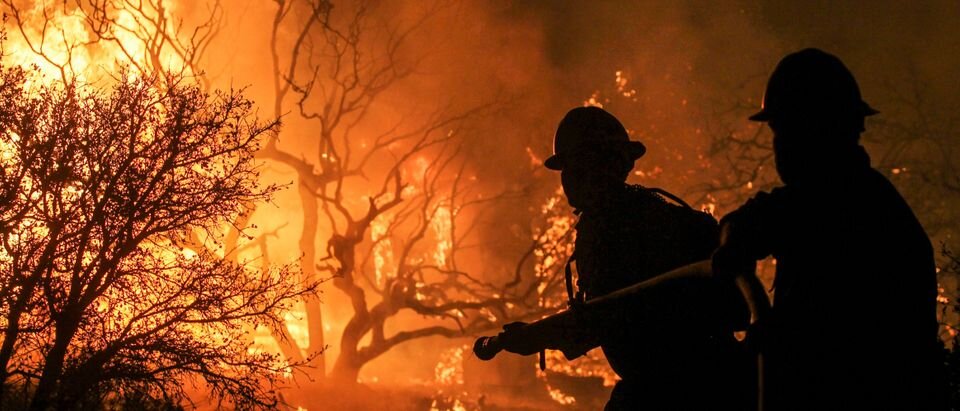Ecological Sustainability Enabled California’s Ecological Armageddon
by John D. O’Connor
This piece was originally published on Daily Caller. Read it HERE.
_________________________
The subsiding California wildfires have devastated the beautiful state’s ecology so harshly that it will take decades to recover, perhaps never completely. While environmentalists are searching to finger-point at familiar targets — global warming being the usual suspect — activists should instead look in the mirror.
The truth is as ugly as it is undeniable: well-meaning environmental absolutists preaching “ecological sustainability” have hamstrung important, truly ecologically sustainable activities such as timber harvesting, salvage for insect infestation, controlled burns and other time-tested management practices.
If carbon dioxide is the environmental poison declaimed, then uncontrolled, intense forest fires should be seen as society’s major environmental crisis.
California automobiles spew a total of 118 million tons of carbon dioxide annually. Healthy forests “fix” carbon dioxide and emit oxygen, our society’s best method of compensation for auto emissions. Dense, unthinned, insect-infested and drying forests, however, are the environment’s worst enemies.
When forests burn, all sequestered carbon dioxide is released, along with other poisons such as nitrogen oxide (acid rain) and carbon monoxide. One-million six-hundred acres of California forest, burned just in 2018 alone, emitted, at an estimated 450 trees-per-acre, approximately 700 million tons of carbon dioxide, or about six times as much carbon dioxide emitted annually by all the autos in the state.
Fires have boiled beautiful California trout streams, denuded teeming watershed and obliterated the habitat of countless species of birds, woodland creatures and native plants. Should we be worried more about timber harvesting, marginally affecting animal habitat, or preventing the harvest of trees which could incinerate large swaths of land?
The lesson is clear but will likely not be learned.
All firefighting experts agree: the buildup of dense forests, millions of dead, insect-infested trees and massive accumulation of underbrush has been a dangerous reservoir of fuel for uncontrollable wildfires. It is just as clear that for the past 30 years, timber harvesting, both for commercial purposes and salvage or sanitation, has markedly decreased because of environmental regulation.
Congress has by statute proclaimed a strong public interest in the harvesting of timber on public lands. But the plethora of well-meaning environmental groups have vigorously fought timber harvesting, while timber, ranching and recreational interests have warned of forest fires that would destroy the environment.
The environmental activists were pleased with the Carter administration’s regulations burdening timber harvests, taking effect in 1982. In 2002, President Bush announced a more flexible set of rules, claiming that the 192 million acres of national forests needed thinning to avoid intensive forest fires.
The response from supposedly responsible environmentalists was scathing and cynical about Bush’s motives. The headline of a 2002 article in The Guardian says it all: “Bush vows to halt forest fires by cutting trees: Environmentalists say new plan is aimed at favouring Republicans’ friends in logging industry.”
Because the Bush plan did not call for specific activities in any particular forest, the government claimed the plan needed no environmental analysis, which could be performed later for forest-specific programs.
But the environmental coalition sued to block the plan precisely because the encouraged timber harvesting and sanitation activities might harm the habitat of wide-ranging species like the Canada lynx and grizzly bear, as well as “old growth” forests.
Because of this supposed “imminent harm,” the court agreed with the environmentalists that they had “standing” and that indeed the Bush plan required an environmental impact analysis, impossible for 192 million acres.
Accordingly, the Bush Plan was dead on arrival when the case was finally decided as President Obama took office in 2009.
With the demise of the Bush plan, the Obama administration sought a more restrictive scheme. The “Obama Rule” rendered all timber harvesting, livestock grazing and recreation subservient to “ecological sustainability.”
Timber harvesting was restricted only to designated production lands, without a provision for sanitary cleaning of other forests to combat insect infestation and underbrush buildup. Pro-timber plaintiffs in this second case claimed that timber harvesting was discouraged and that the Obama Rule “improperly prioritizes ecological sustainability, ecosystem services, and maintaining and restoring plant and animal communities.”
Plaintiffs specifically complained about the lack of regulatory exceptions for “salvage and sanitation harvesting” in areas not otherwise suited for timber production, thereby increasing fire risk. They argued a lack of timber harvesting exacerbated the buildup of timber and fire fuel over the course of two decades.
Timber harvesters also assert that the 2012 Planning Rule’s perpetuation of the downward trend in timber harvesting will lead to overcrowded forests, and that “as timber harvest levels have declined, more and more fuel accumulates, and there has been an accompanying increase in the loss of forest due to wildfire.”
A large part of the wildfire risk was not simply a loss of timber production but salvage and sanitation harvesting in order to avoid “an increase in the incidence of wildfires and insect infestations in the national forests” and “overgrown and unmanaged forests giving rise to wildfires and insect infestations.”
The court claimed that the alleged harm was “sheer speculation” and that there was no connection shown and that the plaintiffs “fail to support the assumption that there is any causal connection between decreased harvest and increased wildfires.”
We must ask the question that environmentalists do not want to confront: Who enabled the frighteningly intense, devastating, ecological unsustainability?
Timber companies and ranchers, warning us loudly for the past three decades about the risks of increasing forest fires, have been unfairly depicted by environmentalists as money-grubbers seeking to despoil the environment to make a buck while, in fact, they have been championing commonsense “sustainability.”
_________________________
John D. O’Connor is the San Francisco attorney who represented W. Mark Felt during his revelation as Deep Throat in 2005. O’Connor is the author of the book, Postgate: How the Washington Post Betrayed Deep Throat, Covered Up Watergate, and Began Today’s Partisan Advocacy Journalism.
